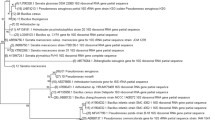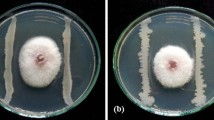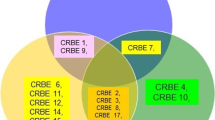Abstract
To investigate the potential of biological control measures against soil-borne plant pathogens, this study evaluated the in vitro and in vivo antifungal activity of endophytic bacteria, Achromobacter xyloxidans, against isolates of Fusarium oxysporum and Fusarium solani responsible of Fusarium wilt of melon (Cucumis melo) in Tunisia. Twenty-one Fusarium isolates were recovered and identified from diseased tissues of different melongrowing regions. The bacterial isolate was recovered and identified from contaminated Petri plates of the Fusarium phytopathogenic isolate. In vitro assay, the results showed positive effects of A. xylosoxidans by reducing significantly 80% of pathogen mycelial growth compared to the control. Furthermore, under greenhouse conditions, A. xylosoxidans significantly reduced 60% of disease severity on melon plants inoculated with Fusarium isolates. According to our results, A. xylosoxidans could be used as a promising and potentially Fusarium disease bio-control agent.







Similar content being viewed by others
References
Bafti, S. S., Bonjar, G. H. S., Aghighi, S., Biglari, S., Farrokhi, P. R., & Aghelizadeh, A. (2005). Biological control of Fusarium oxysporum f.sp. melonis, the causal agent of root rot disease of greenhouse cucurbits in Kerman Province of Iran. American Journal of Biochemistry and Biotechnology, 1(1), 22–26.
Bezert, G., Chappe, P., Mourey, A., & Loubinoux, B. (1996). Action de bacillus et d’actinomycètes sur les champignons du bleuissement du bois. Bulletin des Académies et Sociétés Lorraines des. Sciences, 35, 3.
Booth, C. (1977). Fusarium : Laboratory guide to the identification of the major species. Surrey: Commonwealth mycological Institute, Kew.
Bora, T., Ozaktan, E., Gore, A., & Slan, E. (2004). Biological control of Fusarium oxysporum f. sp. melonis by wettable powder formulations of two strains of Pseudomonas putida. Journal of Phytopathology, 152, 471–475. https://doi.org/10.1111/j.1439-0434.2004.00877.
Burgess, L.W., & Liddell, C.M. 1983. Laboratory manual for Fusarium research. Fusarium Research Laboratory, Department of Plant Pathology and Agricultural Entomology. The University of Sydney, Australia.
Carmichael, J. W., Kendrick, W. B., Conners, L. I., & Singler, L. (1980). Genera of Hyphomycetes. Edmonton: The University of Alberta Press.
Champaco, E. R., Martyn, R. D., & Miller, M. E. (1993). Comparison of Fusarium solani and F. oxysporum as causal agents of fruit rot and root rot of muskmelon. Horticultural Science, 28, 1174–1177.
Chikh-Rouhou, H., Gonzalez-Torres, R., Oumouloud, A., & Alvarez, J. M. (2010). Screening and morphological characterization of melons for resistance to Fusarium oxysporum f.sp melonis race 1.2. Journal of Horticulture Sciences, 45, 1021–1025.
Compant, S., Reiter, A., Sessitsch, J., Nowak, C., Clement, A., & Itbarka, E. (2005). Endophytic colonization of Vitis vinifera by a plant growth promoting bacterium, burkholderia sp.strain PsJN. Journal of Applied and Environmental Microbiology. https://doi.org/10.1128/AEM.71.4.1685-1693.
De Boer, M., Van der Sluis, L., Van Loon, L. C., & Bakker, A. H. M. P. (1999). Combining fluorescent Pseudomonas spp. strains to enhance suppression of Fusarium wilt of radish. European Journal of Plant Pathology, 105(2), 201–210.
Domsch, K. H., Gams, W., & Anderson, T. (2007). Compendium of soil Fungi (2nd ed.). Eching: IHW-Verlag.
El-Hassan, S. A., & Gowen, S. R. (2006). Formulation and delivery of the bacterial antagonist Bacillus subtilis for management of lentil vascular wilt caused by Fusarium oxysporum f. sp. lentis. Journal of Phytopathology. https://doi.org/10.1111/j.1439-0434.2006.01075.
Espinosa, I., Baéz, M., Irian Percedo, M., & Siomara, M. (2013). Evaluation of simplified DNA extraction methods for Streptococcus suis typing. Journal of Revista de Salud Animal, 35(1), 59–63.
Figueiredo, M. V. B., Seldin, L., de Araujo, F. F., & Mariano, R. L. R. (2010). Plant growth promoting Rhizobacteria: Fundamentals and applications. In D. Maheshwari (Ed.), Plant growth and health promoting bacteria. Microbiology monographs (pp. 21–43). Berlin: Springer.
Food and Agriculture Organization statistic (2014). http://www.fao.org. Accessed June 2015.
Hanlin, R. T. (1990). Illustrated genera of ascomycetes. Vols. I. St. Paul: APS Press.
Hanlin, R. T. (1998). Combined keys to illustrated genera of ascomycetes. Vols. I and II. St. Paul: APS Press.
Joseph, B., Patra, R. R., & Lawrence, R. (2007). Characterization of plant growth promoting rhizobacteria associated with chickpea (Cicer arietinum L.). International Journal of Plant Production. https://doi.org/10.22069/IJPP.2012.532.
Kistler, H. C., & Rep, M. (2010). Comparative genomics reveals mobile pathogenicity chromosomes in Fusarium. Nature, 464, 367–373.
Kowalczyk, A., Chyc, M., Ryszka, P., & Latowski, D. (2016). Achromobacter xylosoxidans as a new microorganism strain colonizing high-density polyethylene as a key step to its biodegradation. Journal of Environmental Science and Pollution Research, 23(11), 11349–11356.
Leslie, J. F., & Summerell, B. A. (2006). The Fusarium laboratory manual. Ames: Blackwell Publishing.
Manikanda, R., Saravanakumar, D., Rajendran, L., Raguchander, T., & Samiyappan, R. (2010). Standardization of liquid formulation of Pseudomonas fluorescens Pf1 for its efficacy against Fusarium wilt of tomato. Journal of Biology Control, 54, 83–89. https://doi.org/10.1016/j.biocontrol.2010.04.004.
Meena, R., Radhajeyalakshmi, R., Marimuthu, T., Vidhyasekaran, P., Sabitha, D., & Velazhahan, R. (2000). Induction of pathogenesis-related proteins, phenolics and phenylalanine ammonia-lyase in groundnut by Pseudomonas fluorescens. Journal of Plant Diseases and Protection, 107(5), 467–472.
Nawangsih, A. A., & Purba, F. (2013). Isolation of fluorescent Pseudomonads, heat tolerant and chitinolytic bacteria in banana rhizosphere with antagonistic activities against Fusarium oxysporum f. sp. cubense in vitro and molecular identification of selected isolates. Journal of International Society for Southeast Asian Agricultural Sciences, 19(2), 30–40.
Nelson, P. E., Toussoun, T. A., & Marasas, W. F. O. (1983). Fusarium species: An illustrated manual for identification. Pennsylvania: Pennsylvania State University Press.
Ngoma, L., Esau, B., & Babalola, O. O. (2013). Isolation and characterization of beneficial indigenous endophytic bacteria for plant growth promoting activity in Molelwane farm, Mafikeng, South Africa. African Journal of Biotechnology, 26(12), 4105–4114.
Parke, J. L., Rand, R. E., Joy, A. E., & King, E. B. (1991). Biological control of Pythium damping-off and Aphanomyces root rot of peas by application of Pseudomonas cepacia or P. fluorescens to seed. Plant Disease, 75, 987–992.
Registeri, R., Taghayi, S. M., & Banihashemi, Z. (2012). Effect of root colonizing bacteria on plant growth and Fusarium wilt in Cucumis melo. Journal of Agricultural Sciences and Technology, 14(5), 1121–1131.
Satlewal, A., Ravindra, S., Zaidi, M., Shouche, Y., & Goel, R. (2008). Comparative biodegradation of HDPE and LDPE using an indigenously developed microbial consortium. Journal of Microbiology and Biotechnology, 18(3), 477–482.
Song, W. T., Zhou, L. G., Yang, C. Z., Cao, X. D., Zhang, L. Q., & Liu, X. L. (2004). Tomato Fusarium wilt and its chemical control strategies in a hydroponic system. Journal of Crop Protection, 23, 243–247. https://doi.org/10.1016/j.cropro.2003.08.007.
Suárez-Estrella, F., Vargas-García, M. C., López, M. J., Capel, C., & Moreno, J. (2007). Antagonistic activity of bacteria and fungi from horticultural compost against Fusarium oxysporum f. sp. melonis. Journal of Crop Protection. https://doi.org/10.1016/j.cropro.2006.04.003.
Trapero-Casas, A., Kaiser, W. J., & Ingram, D. M. (1990). Control of Pythium seed rot and preemergence damping-off of chickpea in the US, pacific north west and Spain. Plant Disease, 74, 563–568.
Tziros, G., Lagopodi, A. L., & Tzavella-klonari, K. (2007). Reduction of Fusarium wilt watermelon by Pseudomonas chlororaphis PCL1391 and Pseudomonas fluorescens WCS365. Journal of Phytopathologia Mediterranea. https://doi.org/10.14601/Phytopathol_Mediterr-2245.
Vidhyasekaran, P., Velazhahan, R., & Balasubramanian, P. (2000). Biological control of crop diseases exploiting genes involved in systemic induced resistance. In R. K. Upadhyay et al. (Eds.), Biocontrol potential and its exploitation in sustainable agriculture (pp. 1–8). New York: Springer.
Vidhyasekaran, P., Kamala, N., Ramanathan, A., Rajappan, K., Paranidharan, V., & Velazhahan, R. (2001). Induction of systemic resistance by Pseudomonas flurescens f1 against Xanthomonas oryzae v. oryzae in rice leave. Journal of Phytoparasitica, 29, 155–166.
Weller, D. M., & Cook, R. J. (1983). Suppression of take-all of wheat by seed treatment with fluorescent pseudomonads. Journal of Disease Control and Pest Management, 73(3), 463–469.
Yamamoto, S., & Harayama, S. (1995). PCR amplification and direct sequencing of gyrB genes with universal primers and their amplification to the detection and taxonomic analysis of Pseudomonas putida strains. Journal of Applied Environmental Microbiology, 61(3), 1104–1109.
Yigit, F., & Dikilitas, M. (2007). Control of Fusarium wilt of tomato by combination of Fluorescent Pseudomonas, non-pathogen Fusarium and Trichoderma harzianum T-22 in greenhouse conditions. Journal of Plant Pathology, 6(2), 159–163.
Acknowledgments
The authors would like to thank Christie Nielsen Chaar for assistance with the English language editing.
Author information
Authors and Affiliations
Corresponding author
Ethics declarations
Disclosure of potential conflicts of interests
Funding: This study and financial support for attending symposia were funded by the laboratory of plant protection at the National Agronomic Institute of Tunisia.
Conflict of interest: The authors declare that they have no conflict of interest.
Research involving human participants and/ or animals
a) Statement of human rights
Ethical approval: All procedures performed in this study involving human participants were in accordance with the ethical standards of the National Agronomic Institute of Tunisia.
b) Statement on the welfare of animals
This chapter does not contain any studies with human participants or animals performed by any of the authors.
Informed consent
Informed consent was obtained from all individual participants included in the study.
Rights and permissions
About this article
Cite this article
Dhaouadi, S., Rouissi, W., Mougou-Hamdane, A. et al. Evaluation of biocontrol potential of Achromobacter xylosoxidans against Fusarium wilt of melon. Eur J Plant Pathol 154, 179–188 (2019). https://doi.org/10.1007/s10658-018-01646-2
Accepted:
Published:
Issue Date:
DOI: https://doi.org/10.1007/s10658-018-01646-2




